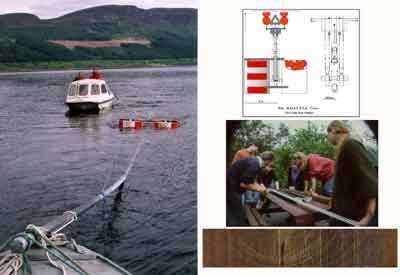
The great depths of Loch Ness provide an especially stable resting place for the rain of particles from above. In shallower lakes, the silt can be re-suspended by water currents thus blurring the sequences but in Loch Ness the sediments build an undisturbed time capsule of events within the lake, the surrounding catchment and much further afield. Studies of cores recovered by the ROSETTA Project have provided a variety of information.
Most of the sediment comes into the loch over winter due to the increased rainfall and consists of particles of decaying vegetation which has grown along the river banks. This pattern together with the different settling rates of organic and mineral particles produces distinct colour bands or "laminations". As the key to these laminations is deciphered, they will provide a history of change since the Ice Age and also the environmental impact of human activities. For example, in summer there is an increase in microscopic plants called Diatoms. They have silica cases which endure, locked in the sediment and can be identified. Since the requirements of many species are known with regard to temperature, nutrient richness and acidity, it is possible to reconstruct a quite detailed picture of conditions over time.
Two of today's concerns over lakes are the effects of acid rain and nutrient enrichment (eutrophication). Work at University College London shows that despite considerable levels of sulphur deposition from atmospheric contamination, the loch has been buffered against acidification. On the other hand, there are no grounds for complacency. Increases in the proportion of open water Diatoms as opposed to shoreline ones, point to a small enrichment probably due to human settlements and agriculture.
Other work traces the increase of heavy metal inputs from industrialisation together with carcinogenic chemicals such as PCBs and PAHs. Radioactive isotope analysis shows clearly the shadow of the 1963 peak in atmospheric nuclear bomb testing and just 4cm down the fall-out from the Chernobyl accident of 1986.
In fact the rapid decay of a naturally occurring isotope called Lead 210, is helpful in dating events over the last 150 years. Through this approach, it seems that a mysterious clay layer, about 30cms down in the sediment, results from powerful erosion during a great flood in 1868. In 1993, a hundred and twenty five years later, work on cores suggests that so much water and silt came down the rivers into Urquhart bay that an underwater avalanche was triggered, spreading a deposit of sand out into the loch. Ultimately the finer clay particles settled to blanket the deep basin thus providing a "marker layer" and enabling the rapid dating of other cores.
The longer cores contain almost indestructible pollen grains which are now
shedding light on the history of vegetation around the loch since the ice retreated
and advanced in a tundra landscape 10,000 years ago. Then forests grew up and
were cut down as man began farming in the glen. Finally, the new forestry plantations
were established. Seismic work shows that the sediments are at least 20m deep,
guaranteeing the scientific importance of the site. It may even conceal sediments
laid down before the last glaciation.
Close
Window
This page copyright Shine, LNP